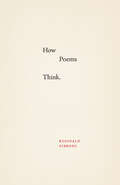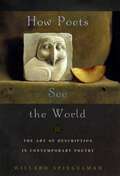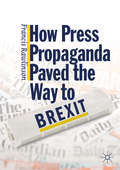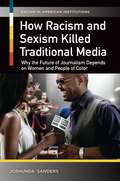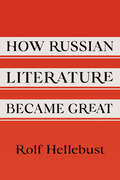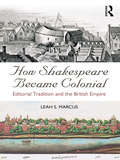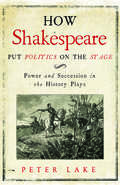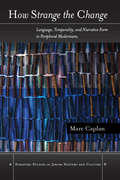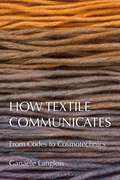- Table View
- List View
How Poems Think
by Reginald GibbonsTo write or read a poem is often to think in distinctively poetic ways—guided by metaphors, sound, rhythms, associative movement, and more. Poetry’s stance toward language creates a particular intelligence of thought and feeling, a compressed articulation that expands inner experience, imagining with words what cannot always be imagined without them. Through translation, poetry has diversified poetic traditions, and some of poetry’s ways of thinking begin in the ancient world and remain potent even now. In How Poems Think, Reginald Gibbons presents a rich gallery of poetic inventiveness and continuity drawn from a wide range of poets—Sappho, Pindar, Shakespeare, Keats, William Carlos Williams, Marina Tsvetaeva, Gwendolyn Brooks, and many others. Gibbons explores poetic temperament, rhyme, metonymy, etymology, and other elements of poetry as modes of thinking and feeling. In celebration and homage, Gibbons attunes us to the possibilities of poetic thinking.
How Poems Think
by Reginald GibbonsTo write or read a poem is often to think in distinctively poetic ways—guided by metaphors, sound, rhythms, associative movement, and more. Poetry’s stance toward language creates a particular intelligence of thought and feeling, a compressed articulation that expands inner experience, imagining with words what cannot always be imagined without them. Through translation, poetry has diversified poetic traditions, and some of poetry’s ways of thinking begin in the ancient world and remain potent even now. In How Poems Think, Reginald Gibbons presents a rich gallery of poetic inventiveness and continuity drawn from a wide range of poets—Sappho, Pindar, Shakespeare, Keats, William Carlos Williams, Marina Tsvetaeva, Gwendolyn Brooks, and many others. Gibbons explores poetic temperament, rhyme, metonymy, etymology, and other elements of poetry as modes of thinking and feeling. In celebration and homage, Gibbons attunes us to the possibilities of poetic thinking.
How Poems Think
by Reginald GibbonsTo write or read a poem is often to think in distinctively poetic ways—guided by metaphors, sound, rhythms, associative movement, and more. Poetry’s stance toward language creates a particular intelligence of thought and feeling, a compressed articulation that expands inner experience, imagining with words what cannot always be imagined without them. Through translation, poetry has diversified poetic traditions, and some of poetry’s ways of thinking begin in the ancient world and remain potent even now. In How Poems Think, Reginald Gibbons presents a rich gallery of poetic inventiveness and continuity drawn from a wide range of poets—Sappho, Pindar, Shakespeare, Keats, William Carlos Williams, Marina Tsvetaeva, Gwendolyn Brooks, and many others. Gibbons explores poetic temperament, rhyme, metonymy, etymology, and other elements of poetry as modes of thinking and feeling. In celebration and homage, Gibbons attunes us to the possibilities of poetic thinking.
How Poems Think
by Reginald GibbonsTo write or read a poem is often to think in distinctively poetic ways—guided by metaphors, sound, rhythms, associative movement, and more. Poetry’s stance toward language creates a particular intelligence of thought and feeling, a compressed articulation that expands inner experience, imagining with words what cannot always be imagined without them. Through translation, poetry has diversified poetic traditions, and some of poetry’s ways of thinking begin in the ancient world and remain potent even now. In How Poems Think, Reginald Gibbons presents a rich gallery of poetic inventiveness and continuity drawn from a wide range of poets—Sappho, Pindar, Shakespeare, Keats, William Carlos Williams, Marina Tsvetaeva, Gwendolyn Brooks, and many others. Gibbons explores poetic temperament, rhyme, metonymy, etymology, and other elements of poetry as modes of thinking and feeling. In celebration and homage, Gibbons attunes us to the possibilities of poetic thinking.
How Poets See the World: The Art of Description in Contemporary Poetry
by Willard SpiegelmanAlthough readers of prose fiction sometimes find descriptive passages superfluous or boring, description itself is often the most important aspect of a poem. This book examines how a variety of contemporary poets use description in their work. Description has been the great burden of poetry. How do poets see the world? How do they look at it? What do they look for? Is description an end in itself, or a means of expressing desire? Ezra Pound demanded that a poem should represent the external world as objectively and directly as possible, and William Butler Yeats, in his introduction to The Oxford Book of Modern Verse (1936), said that he and his generation were rebelling against, inter alia, "irrelevant descriptions of nature" in the work of their predecessors. The poets in this book, however, who are distinct in many ways from one another, all observe the external world of nature or the reflected world of art, and make relevant poems out of their observations. This study deals with the crisp, elegant work of Charles Tomlinson, the swirling baroque poetry of Amy Clampitt, the metaphysical meditations of Charles Wright from a position in his backyard, the weather reports and landscapes of John Ashbery, and the "new way of looking" that Jorie Graham proposes to explore in her increasingly fragmented poems. All of these poets, plus others (Gary Snyder, Theodore Weiss, Irving Feldman, Richard Howard) who are dealt with more briefly, attend to what Wallace Stevens, in a memorable phrase, calls "the way things look each day." The ordinariness of daily reality is the beginning of the poets' own idiosyncratic, indeed unique, visions and styles.
How Poets See the World: The Art of Description in Contemporary Poetry
by Willard SpiegelmanAlthough readers of prose fiction sometimes find descriptive passages superfluous or boring, description itself is often the most important aspect of a poem. This book examines how a variety of contemporary poets use description in their work. Description has been the great burden of poetry. How do poets see the world? How do they look at it? What do they look for? Is description an end in itself, or a means of expressing desire? Ezra Pound demanded that a poem should represent the external world as objectively and directly as possible, and William Butler Yeats, in his introduction to The Oxford Book of Modern Verse (1936), said that he and his generation were rebelling against, inter alia, "irrelevant descriptions of nature" in the work of their predecessors. The poets in this book, however, who are distinct in many ways from one another, all observe the external world of nature or the reflected world of art, and make relevant poems out of their observations. This study deals with the crisp, elegant work of Charles Tomlinson, the swirling baroque poetry of Amy Clampitt, the metaphysical meditations of Charles Wright from a position in his backyard, the weather reports and landscapes of John Ashbery, and the "new way of looking" that Jorie Graham proposes to explore in her increasingly fragmented poems. All of these poets, plus others (Gary Snyder, Theodore Weiss, Irving Feldman, Richard Howard) who are dealt with more briefly, attend to what Wallace Stevens, in a memorable phrase, calls "the way things look each day." The ordinariness of daily reality is the beginning of the poets' own idiosyncratic, indeed unique, visions and styles.
How Press Propaganda Paved the Way to Brexit
by Francis RawlinsonThis book traces how right-wing newspapers in Britain helped shape British public opinion about the European Union over the course of the 20 years preceding the EU referendum in June 2016. The author argues that newspapers such as the Telegraph, Mail, Sun and Express have been effectively waging a long-term propaganda war, with the distortions and borderline fake news presented one of the factors that helped secure the narrow majority for Brexit. Written by an EU insider, the book presents hard facts and debunks the core myths on EU laws, exorbitant budget contributions, and uncontrolled immigration, as it contributes to the debate on the importance of the press for democracy more broadly.
How Propaganda Works
by Jason StanleyHow propaganda undermines democracy and why we need to pay attentionOur democracy today is fraught with political campaigns, lobbyists, liberal media, and Fox News commentators, all using language to influence the way we think and reason about public issues. Even so, many of us believe that propaganda and manipulation aren't problems for us—not in the way they were for the totalitarian societies of the mid-twentieth century. In How Propaganda Works, Jason Stanley demonstrates that more attention needs to be paid. He examines how propaganda operates subtly, how it undermines democracy—particularly the ideals of democratic deliberation and equality—and how it has damaged democracies of the past.Focusing on the shortcomings of liberal democratic states, Stanley provides a historically grounded introduction to democratic political theory as a window into the misuse of democratic vocabulary for propaganda's selfish purposes. He lays out historical examples, such as the restructuring of the US public school system at the turn of the twentieth century, to explore how the language of democracy is sometimes used to mask an undemocratic reality. Drawing from a range of sources, including feminist theory, critical race theory, epistemology, formal semantics, educational theory, and social and cognitive psychology, he explains how the manipulative and hypocritical declaration of flawed beliefs and ideologies arises from and perpetuates inequalities in society, such as the racial injustices that commonly occur in the United States.How Propaganda Works shows that an understanding of propaganda and its mechanisms is essential for the preservation and protection of liberal democracies everywhere.
How Proust Can Change Your Life (Picador Classic #96)
by Alain de BottonWith an introduction by comedian and novelist David BaddielA novel in seven volumes, Marcel Proust’s In Search of Lost Time is considered a major literary work of the twentieth century. And even more crucially, one that you should have read by now. However, as one of its most distinguishing features is its staggering length, many of us feel intimidated and perhaps, even, fatigued at the thought of diving in. Alain de Botton’s hilarious and unexpected Proustian manual, is then, the perfect antidote to this problem.In How Proust Can Change Your Life, de Botton masterfully distils what Proust says about friendship, reading, being alive and taking your time, and mixes it with his own, no less nourishing commentary. As de Botton rereads Proust for our collective benefit, we see the continued relevance of his work and the rich and varied insights he can offer us, from how to reinvigorate your relationship to being a good host. This is Proust as you’ve never seen him before. He may even change your life.
How Racism and Sexism Killed Traditional Media: Why the Future of Journalism Depends on Women and People of Color (Racism in American Institutions)
by Joshunda SandersAn evaluative examination that challenges the media to rise above the systematic racism and sexism that persists across all channels, despite efforts to integrate.The Internet and social networks have opened up new avenues of communication for women and people of color, but the mainstream news is still not adequately including minority communities in the conversation. Part of the Racism in America series, How Racism and Sexism Killed the Traditional Media: Why the Future of Journalism Depends on Women and People of Color reveals the lack of diversity that persists in the communication industry. Uncovering and analyzing the racial bias in the media and in many newsrooms, this book reveals the lesser-known side of the media—newsrooms and outlets that are often fraught with underlying racist and sexist tension.Written by a veteran journalist of color, this title brings an insider's perspective combined with interviews from industry experts. The book analyzes the traditional media's efforts to integrate both women and people of color into legacy newsrooms, highlighting their defeats and minor successes. The author examines the future of women and people of color in the mainstream media.
How Racism and Sexism Killed Traditional Media: Why the Future of Journalism Depends on Women and People of Color (Racism in American Institutions)
by Joshunda SandersAn evaluative examination that challenges the media to rise above the systematic racism and sexism that persists across all channels, despite efforts to integrate.The Internet and social networks have opened up new avenues of communication for women and people of color, but the mainstream news is still not adequately including minority communities in the conversation. Part of the Racism in America series, How Racism and Sexism Killed the Traditional Media: Why the Future of Journalism Depends on Women and People of Color reveals the lack of diversity that persists in the communication industry. Uncovering and analyzing the racial bias in the media and in many newsrooms, this book reveals the lesser-known side of the media—newsrooms and outlets that are often fraught with underlying racist and sexist tension.Written by a veteran journalist of color, this title brings an insider's perspective combined with interviews from industry experts. The book analyzes the traditional media's efforts to integrate both women and people of color into legacy newsrooms, highlighting their defeats and minor successes. The author examines the future of women and people of color in the mainstream media.
How Romantics and Victorians Organized Information: Commonplace Books, Scrapbooks, and Albums (Oxford Textual Perspectives)
by Jillian M. HessEvery literary household in nineteenth-century Britain had a commonplace book, scrapbook, or album. Coleridge called his collection "Fly-Catchers", while George Eliot referred to one of her commonplace books as a "Quarry," and Michael Faraday kept quotations in his "Philosophical Miscellany." Nevertheless, the nineteenth-century commonplace book, along with associated traditions like the scrapbook and album, remain under-studied. This book tells the story of how technological and social changes altered methods for gathering, storing, and organizing information in nineteenth-century Britain. As the commonplace book moved out of the schoolroom and into the home, it took on elements of the friendship album. At the same time, the explosion of print allowed readers to cheaply cut-and-paste extractions rather than copying out quotations by hand. Built on the evidence of over 300 manuscripts, this volume unearths the composition practices of well-known writers such as Samuel Taylor Coleridge, Sir Walter Scott, George Eliot, and Alfred Lord Tennyson, and their less well-known contemporaries. Divided into two sections, the first half of the book contends that methods for organizing knowledge developed in line with the period's dominant epistemic frameworks, while the second half argues that commonplace books helped Romantics and Victorians organize people. Chapters focus on prominent organizational methods in nineteenth-century commonplacing, often attached to an associated epistemic virtue: diaristic forms and the imagination (Chapter Two); "real time" entries signalling objectivity (Chapter Three); antiquarian remnants, serving as empirical evidence for historical arguments (Chapter Four); communally produced commonplace books that attest to socially constructed knowledge (Chapter Five); and blank spaces in commonplace books of mourning (Chapter Six). Richly illustrated, this book brings an archive of commonplace books, scrapbooks, and albums to the reader.
How Romantics and Victorians Organized Information: Commonplace Books, Scrapbooks, and Albums (Oxford Textual Perspectives)
by Jillian M. HessEvery literary household in nineteenth-century Britain had a commonplace book, scrapbook, or album. Coleridge called his collection "Fly-Catchers", while George Eliot referred to one of her commonplace books as a "Quarry," and Michael Faraday kept quotations in his "Philosophical Miscellany." Nevertheless, the nineteenth-century commonplace book, along with associated traditions like the scrapbook and album, remain under-studied. This book tells the story of how technological and social changes altered methods for gathering, storing, and organizing information in nineteenth-century Britain. As the commonplace book moved out of the schoolroom and into the home, it took on elements of the friendship album. At the same time, the explosion of print allowed readers to cheaply cut-and-paste extractions rather than copying out quotations by hand. Built on the evidence of over 300 manuscripts, this volume unearths the composition practices of well-known writers such as Samuel Taylor Coleridge, Sir Walter Scott, George Eliot, and Alfred Lord Tennyson, and their less well-known contemporaries. Divided into two sections, the first half of the book contends that methods for organizing knowledge developed in line with the period's dominant epistemic frameworks, while the second half argues that commonplace books helped Romantics and Victorians organize people. Chapters focus on prominent organizational methods in nineteenth-century commonplacing, often attached to an associated epistemic virtue: diaristic forms and the imagination (Chapter Two); "real time" entries signalling objectivity (Chapter Three); antiquarian remnants, serving as empirical evidence for historical arguments (Chapter Four); communally produced commonplace books that attest to socially constructed knowledge (Chapter Five); and blank spaces in commonplace books of mourning (Chapter Six). Richly illustrated, this book brings an archive of commonplace books, scrapbooks, and albums to the reader.
How Russian Literature Became Great (NIU Series in Slavic, East European, and Eurasian Studies)
by Rolf HellebustHow Russian Literature Became Great explores the cultural and political role of a modern national literature, orchestrated in a Slavonic key but resonating far beyond Russia's borders. Rolf Hellebust investigates a range of literary tendencies, philosophies, and theories from antiquity to the present: Roman jurisprudence to German Romanticism, French Enlightenment to Czech Structuralism, Herder to Hobsbawm, Samuel Johnson to Sainte-Beuve, and so on. Besides the usual Russian suspects from Pushkin to Chekhov, Hellebust includes European writers: Byron and Shelley, Goethe and Schiller, Chateaubriand and Baudelaire, Dante, Mickiewicz, and more. As elsewhere, writing in Russia advertises itself via a canon of literary monuments constituting an atemporal "ideal order among themselves" (T.S. Eliot). And yet this is a tradition that could only have been born at a specific moment in the golden nineteenth-century age of historiography and nation-building. The Russian example reveals the contradictions between immutability and innovation, universality and specificity at the heart of modern conceptions of tradition from Sainte-Beuve through Eliot and down to the present day. The conditions of its era of formation—the prominence of the crucial literary-historical question of the writer's social function, and the equation of literature with national identity—make the Russian classical tradition the epitome of a unified cultural text, with a complex narrative in which competing stories of progress and decline unfold through the symbolic biographical encounters of the authors who constitute its members. How Russian Literature Became Great thus offers a new paradigm for understanding the paradoxes of modern tradition.
How Shakespeare Became Colonial: Editorial Tradition and the British Empire
by Leah S. MarcusIn this fascinating book, Leah S. Marcus argues that the colonial context in which Shakespeare was edited and disseminated during the heyday of the British Empire has left a mark on Shakespeare’s texts to the present day. How Shakespeare Became Colonial offers a unique and engaging argument, including: A brief history of the colonial importance of editing Shakespeare; The colonially inflected racism that hides behind the editing of Othello; The editing of female characters – colonization as sexual conquest; The significance of editions that were specifically created for schools in India during British colonial rule. Marcus traces important ways in which the colonial enterprise of setting forth the best possible Shakespeare for world consumption has continued to be visible in the recent treatment of his playtexts today, despite our belief that we are global or postcolonial in approach.
How Shakespeare Became Colonial: Editorial Tradition and the British Empire
by Leah S. MarcusIn this fascinating book, Leah S. Marcus argues that the colonial context in which Shakespeare was edited and disseminated during the heyday of the British Empire has left a mark on Shakespeare’s texts to the present day. How Shakespeare Became Colonial offers a unique and engaging argument, including: A brief history of the colonial importance of editing Shakespeare; The colonially inflected racism that hides behind the editing of Othello; The editing of female characters – colonization as sexual conquest; The significance of editions that were specifically created for schools in India during British colonial rule. Marcus traces important ways in which the colonial enterprise of setting forth the best possible Shakespeare for world consumption has continued to be visible in the recent treatment of his playtexts today, despite our belief that we are global or postcolonial in approach.
How Shakespeare Put Politics on the Stage: Power and Succession in the History Plays
by Peter LakeA masterful, highly engaging analysis of how Shakespeare’s plays intersected with the politics and culture of Elizabethan England With an ageing, childless monarch, lingering divisions due to the Reformation, and the threat of foreign enemies, Shakespeare’s England was fraught with unparalleled anxiety and complicated problems. In this monumental work, Peter Lake reveals, more than any previous critic, the extent to which Shakespeare’s plays speak to the depth and sophistication of Elizabethan political culture and the Elizabethan imagination. Lake reveals the complex ways in which Shakespeare’s major plays engaged with the events of his day, particularly regarding the uncertain royal succession, theological and doctrinal debates, and virtue and virtù in politics. Through his plays, Lake demonstrates, Shakespeare was boldly in conversation with his audience about a range of contemporary issues. This remarkable literary and historical analysis pulls the curtain back on what Shakespeare was really telling his audience and what his plays tell us today about the times in which they were written.
How Stories Change Us: A Developmental Science of Stories from Fiction and Real Life
by Elaine ReeseIn recent years, gold-standard experimental evidence on the benefits of reading fiction has exploded. Why do we love stories from books, TV and movies, and videogames? What do fictional stories have to do with stories from real life? How do stories impact our own and our children's brain development, reading skills, social understanding, and well-being? In How Stories Change Us, Elaine Reese integrates the latest scientific research on stories from fiction (books, TV shows and movies, videogames) with stories from real life (our personal experiences, including on social media) across the lifespan. The book offers an authoritative yet accessible overview of the new interdisciplinary science of stories, told by a developmental psychologist and autobiographical memory expert with over thirty years of experience conducting research on stories. Throughout, Reese adopts a developmental perspective by tracing the impact of stories from pre-birth to old age. Drawing upon illustrative examples from her 20-year longitudinal study Origins of Memory as well as from her own life, Reese synthesizes cutting-edge research on the benefits and pitfalls of stories and offers practical tips for parents, teachers, librarians, and policymakers. Reese concludes that people have a preferred fictional story delivery system, whether it's reading, watching, or gaming, and she advocates for a more integrated science of stories to allow us to better choose the stories we consume and tell.
How Stories Change Us: A Developmental Science of Stories from Fiction and Real Life
by Elaine ReeseIn recent years, gold-standard experimental evidence on the benefits of reading fiction has exploded. Why do we love stories from books, TV and movies, and videogames? What do fictional stories have to do with stories from real life? How do stories impact our own and our children's brain development, reading skills, social understanding, and well-being? In How Stories Change Us, Elaine Reese integrates the latest scientific research on stories from fiction (books, TV shows and movies, videogames) with stories from real life (our personal experiences, including on social media) across the lifespan. The book offers an authoritative yet accessible overview of the new interdisciplinary science of stories, told by a developmental psychologist and autobiographical memory expert with over thirty years of experience conducting research on stories. Throughout, Reese adopts a developmental perspective by tracing the impact of stories from pre-birth to old age. Drawing upon illustrative examples from her 20-year longitudinal study Origins of Memory as well as from her own life, Reese synthesizes cutting-edge research on the benefits and pitfalls of stories and offers practical tips for parents, teachers, librarians, and policymakers. Reese concludes that people have a preferred fictional story delivery system, whether it's reading, watching, or gaming, and she advocates for a more integrated science of stories to allow us to better choose the stories we consume and tell.
How Strange the Change: Language, Temporality, and Narrative Form in Peripheral Modernisms (Stanford Studies in Jewish History and Culture)
by Marc CaplanIn this book, Marc Caplan argues that the literatures of ostensibly marginal modern cultures are key to understanding modernism. Caplan undertakes an unprecedented comparison of nineteenth-century Yiddish literature and twentieth-century Anglophone and Francophone African literature and reveals unexpected similarities between them. These literatures were created under imperial regimes that brought with them processes of modernization that were already well advanced elsewhere. Yiddish and African writers reacted to the liberating potential of modernity and the burdens of imperial authority by choosing similar narrative genres, typically reminiscent of early-modern European literatures: the picaresque, the pseudo-autobiography, satire, and the Bildungsroman. Both display analogous anxieties toward language, caught as they were between imperial, "global" languages and stigmatized native vernaculars, and between traditions of writing and orality. Through comparative readings of narratives by Reb Nakhman of Breslov, Amos Tutuola, Yisroel Aksenfeld, Cheikh Hamidou Kane, Isaac Meyer Dik, Camara Laye, Mendele Moykher-Sforim, Wole Soyinka, Y. Y. Linetski, and Ahmadou Karouma, Caplan demonstrates that these literatures' "belated" relationship to modernization suggests their potential to anticipate subsequent crises in the modernity and post-modernity of metropolitan cultures. This, in turn, leads him to propose a new theoretical model, peripheral modernism, which incorporates both a new understanding of "periphery" and "center" in modernity and a new methodology for comparative literary criticism and theory.
How Tell a Story and Others
by Mark TwainThe Humorous Story an American Development. Its Difference from Comic and Witty Stories.
How Textile Communicates: From Codes to Cosmotechnics
by Dr. Ganaele LangloisTextile has been used as a medium of communication since the prehistoric period. Up until the 19th century, civilizations throughout the world manipulated thread and fabric to communicate in a way that would astound many of us now. Unlike text and images, textile is haptic and three-dimensional. Its meaning is unfixed, constantly shifting as it circulates between different owners and creators. In How Textile Communicates, Ganaele Langlois dissects textile's unique capacity for communication through a range of global case studies, before examining the profound impact of colonialism on textile practice and the appropriation of this medium by capitalist systems. A thought-provoking contribution to the fields of both fashion and communication studies, Langlois' writing challenges readers' preconceptions and shines new light on the profound impact of textiles on human communication.
How Textile Communicates: From Codes to Cosmotechnics
by Dr. Ganaele LangloisTextile has been used as a medium of communication since the prehistoric period. Up until the 19th century, civilizations throughout the world manipulated thread and fabric to communicate in a way that would astound many of us now. Unlike text and images, textile is haptic and three-dimensional. Its meaning is unfixed, constantly shifting as it circulates between different owners and creators. In How Textile Communicates, Ganaele Langlois dissects textile's unique capacity for communication through a range of global case studies, before examining the profound impact of colonialism on textile practice and the appropriation of this medium by capitalist systems. A thought-provoking contribution to the fields of both fashion and communication studies, Langlois' writing challenges readers' preconceptions and shines new light on the profound impact of textiles on human communication.
How Texts Work
by Adrian BeardHow Texts Work: explores the ways in which we categorize texts reveals the limitations of some of the polarisations we use to categorize texts analyzes a wide variety of texts from a range of genres and periods, from Ibsen's A Doll's House to an 18-30s brochure, Internet chatrooms and George Bush's September 11 speech offers a step-by-step guide to approaching texts and structuring a response can be used as both a course stimulus and a revision tool. Written by an experienced teacher, author and AS and A2 level examiner, How Texts Work is an essential resource for all students of AS and A2 level English Language, English Literature, and English Language and Literature.
How Texts Work
by Adrian BeardHow Texts Work: explores the ways in which we categorize texts reveals the limitations of some of the polarisations we use to categorize texts analyzes a wide variety of texts from a range of genres and periods, from Ibsen's A Doll's House to an 18-30s brochure, Internet chatrooms and George Bush's September 11 speech offers a step-by-step guide to approaching texts and structuring a response can be used as both a course stimulus and a revision tool. Written by an experienced teacher, author and AS and A2 level examiner, How Texts Work is an essential resource for all students of AS and A2 level English Language, English Literature, and English Language and Literature.
